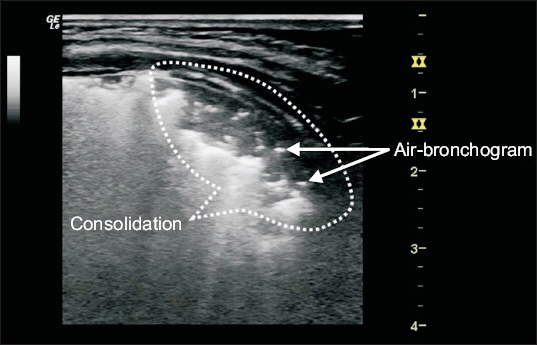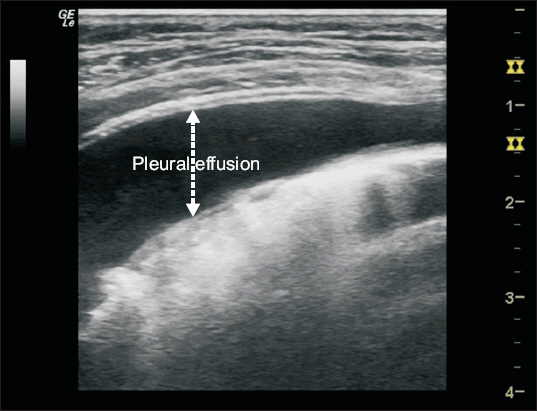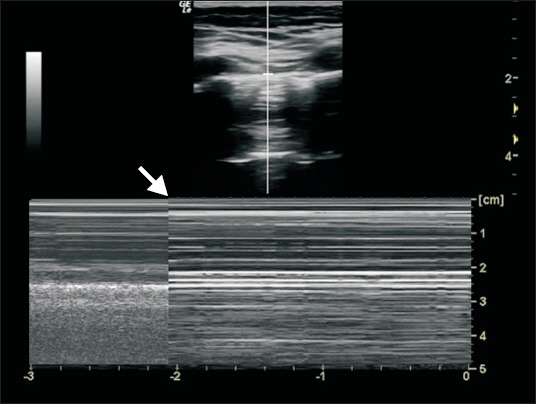Anesth Pain Med.
2018 Jan;13(1):18-22. 10.17085/apm.2018.13.1.18.
Pediatric lung ultrasound: its role in the perioperative period
- Affiliations
-
- 1Department of Anesthesiology and Pain Medicine, Asan Medical Center, University of Ulsan College of Medicine, Seoul, Korea. goingridgo@gmail.com
- KMID: 2436050
- DOI: http://doi.org/10.17085/apm.2018.13.1.18
Abstract
- There have been a number of recent advancements in the field of point-of-care ultrasound, including lung ultrasound for adult and pediatric populations. Evidence-based guidelines on the use of point-of-care lung ultrasound have been published. Lung ultrasound is superior to chest radiography in diagnosing several disorders of vital importance in the perioperative period. This review presents a discussion of techniques and clinical applications of lung ultrasound in pediatric patients focusing on usage in the perioperative period.
Keyword
MeSH Terms
Figure
Reference
-
1. Lichtenstein D, Mezière G. A lung ultrasound sign allowing bedside distinction between pulmonary edema and COPD: the comet-tail artifact. Intensive Care Med. 1998; 24:1331–4. DOI: 10.1007/s001340050771. PMID: 9885889.2. Lichtenstein D, Mezière G, Biderman P, Gepner A. The “lung point”: an ultrasound sign specific to pneumothorax. Intensive Care Med. 2000; 26:1434–40. DOI: 10.1007/s001340000627. PMID: 11126253.3. Lichtenstein DA, Lascols N, Prin S, Mezière G. The “lung pulse”: an early ultrasound sign of complete atelectasis. Intensive Care Med. 2003; 29:2187–92. DOI: 10.1007/s00134-003-1930-9. PMID: 14557855.4. Lichtenstein DA, Menu Y. A bedside ultrasound sign ruling out pneumothorax in the critically ill. Lung sliding. Chest. 1995; 108:1345–8. DOI: 10.1378/chest.108.5.1345. PMID: 7587439.5. Copetti R, Cattarossi L. The ‘double lung point’: an ultrasound sign diagnostic of transient tachypnea of the newborn. Neonatology. 2007; 91:203–9. DOI: 10.1159/000097454. PMID: 17377407.6. Caiulo VA, Gargani L, Caiulo S, Moramarco F, Latini G, Gargasole C, et al. Usefulness of lung ultrasound in a newborn with pulmonary atelectasis. Pediatr Med Chir. 2011; 33:253–5. PMID: 22428435.7. Caiulo VA, Gargani L, Caiulo S, Fisicaro A, Moramarco F, Latini G, et al. Lung ultrasound in bronchiolitis: comparison with chest X-ray. Eur J Pediatr. 2011; 170:1427–33. DOI: 10.1007/s00431-011-1461-2. PMID: 21468639.8. Copetti R, Cattarossi L. Ultrasound diagnosis of pneumonia in children. Radiol Med. 2008; 113:190–8. DOI: 10.1007/s11547-008-0247-8. PMID: 18386121.9. Copetti R, Cattarossi L, Macagno F, Violino M, Furlan R. Lung ultrasound in respiratory distress syndrome: a useful tool for early diagnosis. Neonatology. 2008; 94:52–9. DOI: 10.1159/000113059. PMID: 18196931.10. Darge K, Chen A. Point-of-care ultrasound in diagnosing pneumonia in children. J Pediatr. 2013; 163:302–3. DOI: 10.1016/j.jpeds.2013.04.059. PMID: 23796342.11. Piastra M, Yousef N, Brat R, Manzoni P, Mokhtari M, De Luca D. Lung ultrasound findings in meconium aspiration syndrome. Early Hum Dev. 2014; 90(Suppl 2):S41–3. DOI: 10.1016/S0378-3782(14)50011-4.12. Vergine M, Copetti R, Brusa G, Cattarossi L. Lung ultrasound accuracy in respiratory distress syndrome and transient tachypnea of the newborn. Neonatology. 2014; 106:87–93. DOI: 10.1159/000358227. PMID: 24819542.13. Troianos CA, Hartman GS, Glas KE, Skubas NJ, Eberhardt RT, Walker JD, et al. Guidelines for performing ultrasound guided vascular cannulation: recommendations of the American Society of Echocardiography and the Society of Cardiovascular Anesthesiologists. J Am Soc Echocardiogr. 2011; 24:1291–318. DOI: 10.1016/j.echo.2011.09.021. PMID: 22115322.14. Volpicelli G, Elbarbary M, Blaivas M, Lichtenstein DA, Mathis G, Kirkpatrick AW, et al. International evidence-based recommendations for point-of-care lung ultrasound. Intensive Care Med. 2012; 38:577–91. DOI: 10.1007/s00134-012-2513-4. PMID: 22392031.15. Cattarossi L. Lung ultrasound: its role in neonatology and pediatrics. Early Hum Dev. 2013; 89(Suppl 1):S17–9. DOI: 10.1016/S0378-3782(13)70006-9.16. Acosta CM, Maidana GA, Jacovitti D, Belaunzarán A, Cereceda S, Rae E, et al. Accuracy of transthoracic lung ultrasound for diagnosing anesthesia-induced atelectasis in children. Anesthesiology. 2014; 120:1370–9. DOI: 10.1097/ALN.0000000000000231. PMID: 24662376.17. Cantinotti M, Giordano R, Valverde I. Lung ultrasound: a new basic, easy, multifunction imaging diagnostic tool in children undergoing pediatric cardiac surgery. J Thorac Dis. 2017; 9:1396–9. DOI: 10.21037/jtd.2017.05.71. PMID: 28740641. PMCID: PMC5506126.18. Bouhemad B, Mongodi S, Via G, Rouquette I. Ultrasound for “lung monitoring” of ventilated patients. Anesthesiology. 2015; 122:437–47. DOI: 10.1097/ALN.0000000000000558. PMID: 25501898.19. Piette E, Daoust R, Denault A. Basic concepts in the use of thoracic and lung ultrasound. Curr Opin Anaesthesiol. 2013; 26:20–30. DOI: 10.1097/ACO.0b013e32835afd40. PMID: 23103845.20. Lichtenstein DA, Mauriat P. Lung ultrasound in the critically ill neonate. Curr Pediatr Rev. 2012; 8:217–23. DOI: 10.2174/157339612802139389. PMID: 23255876. PMCID: PMC3522086.21. Ashton-Cleary DT. Is thoracic ultrasound a viable alternative to conventional imaging in the critical care setting? Br J Anaesth. 2013; 111:152–60. DOI: 10.1093/bja/aet076. PMID: 23585400.22. Trinavarat P, Riccabona M. Potential of ultrasound in the pediatric chest. Eur J Radiol. 2014; 83:1507–18. DOI: 10.1016/j.ejrad.2014.04.011. PMID: 24844730.23. de Graaff JC, Bijker JB, Kappen TH, van Wolfswinkel L, Zuithoff NP, Kalkman CJ. Incidence of intraoperative hypoxemia in children in relation to age. Anesth Analg. 2013; 117:169–75. DOI: 10.1213/ANE.0b013e31829332b5. PMID: 23687233.24. Lichtenstein DA. BLUE-protocol and FALLS-protocol: two applications of lung ultrasound in the critically ill. Chest. 2015; 147:1659–70. DOI: 10.1378/chest.14-1313. PMID: 26033127.25. Díaz-Gómez JL, Renew JR, Ratzlaff RA, Ramakrishna H, Via G, Torp K. Can lung ultrasound be the first-line tool for evaluation of intraoperative hypoxemia? Anesth Analg. 2017; Epub ahead of print. DOI: 10.1213/ANE.0000000000002578.






